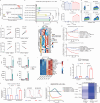Chimeric antigen receptor macrophages (CAR-M) sensitize HER2+ solid tumors to PD1 blockade in pre-clinical models
- PMID: 39814734
- PMCID: PMC11735936
- DOI: 10.1038/s41467-024-55770-1
Chimeric antigen receptor macrophages (CAR-M) sensitize HER2+ solid tumors to PD1 blockade in pre-clinical models
Erratum in
-
Author Correction: Chimeric antigen receptor macrophages (CAR-M) sensitize HER2+ solid tumors to PD1 blockade in pre-clinical models.Nat Commun. 2025 Mar 19;16(1):2692. doi: 10.1038/s41467-025-57496-0. Nat Commun. 2025. PMID: 40108132 Free PMC article. No abstract available.
Abstract
We previously developed human CAR macrophages (CAR-M) and demonstrated redirection of macrophage anti-tumor function leading to tumor control in immunodeficient xenograft models. Here, we develop clinically relevant fully immunocompetent syngeneic models to evaluate the potential for CAR-M to remodel the tumor microenvironment (TME), induce T cell anti-tumor immunity, and sensitize solid tumors to PD1/PDL1 checkpoint inhibition. In vivo, anti-HER2 CAR-M significantly reduce tumor burden, prolong survival, remodel the TME, increase intratumoral T cell and natural killer (NK) cell infiltration, and induce antigen spreading. CAR-M therapy protects against antigen-negative relapses in a T cell dependent fashion, confirming long-term anti-tumor immunity. In HER2+ solid tumors with limited sensitivity to anti-PD1 (aPD1) monotherapy, the combination of CAR-M and aPD1 significantly improves tumor growth control, survival, and remodeling of the TME in pre-clinical models. These results demonstrate synergy between CAR-M and T cell checkpoint blockade and provide a strategy to potentially enhance response to aPD1 therapy for patients with non-responsive tumors.
© 2025. The Author(s).
Conflict of interest statement
Competing interests: M.K. and S.G. are scientific co-founders of Carisma Therapeutics Inc, equity shareholders, and inventors of patents related to this work. S.P., R.G., M.C.O.-N., R.Q., A.W., S.H., K.N., C.G., L.L., Y.O., K.R., C.S., M.B., B.S., P.S., L.C., D.B., S.C., N.M., K.C., L.S., I.Z., D.C., S.C.D, S.A., T.C., and M.K. are employees of Carisma Therapeutics Inc and equity shareholders. H.L and S.G. are Scientific Advisory Board Members and shareholders of Carisma Therapeutics Inc. S.G. has patents related to CAR therapy with royalties paid from Novartis to the University of Pennsylvania. S.G. is a scientific co-founder and holds equity in Interius Biotherapeutics and Carisma Therapeutics Inc. S.G. is a scientific advisor to Carisma, Cartography, Currus, Interius, Kite, NKILT, Mission Bio, and Vor Bio. O.S. declares no competing interests. This work was funded by Carisma Therapeutics Inc which is pursuing the commercial development of related products.
Figures





References
MeSH terms
Substances
LinkOut - more resources
Full Text Sources
Medical
Molecular Biology Databases
Research Materials
Miscellaneous

